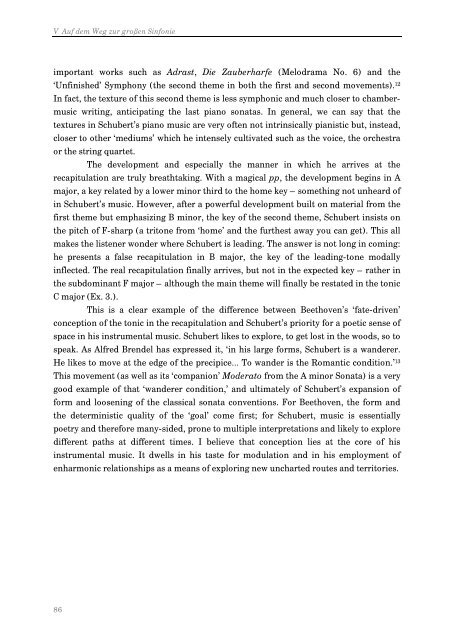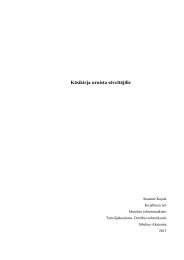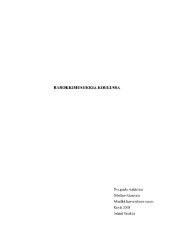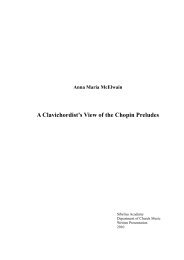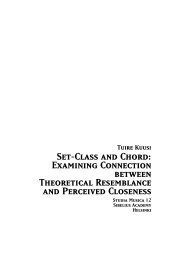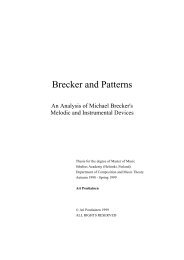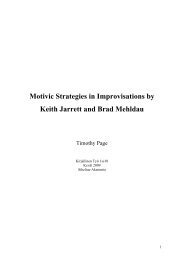The Unfinished Piano Sonatas of Franz Schubert Javier ... - Ethesis
The Unfinished Piano Sonatas of Franz Schubert Javier ... - Ethesis
The Unfinished Piano Sonatas of Franz Schubert Javier ... - Ethesis
Create successful ePaper yourself
Turn your PDF publications into a flip-book with our unique Google optimized e-Paper software.
V Auf dem Weg zur großen Sinfonie<br />
important works such as Adrast, Die Zauberharfe (Melodrama No. 6) and the<br />
‘<strong>Unfinished</strong>’ Symphony (the second theme in both the first and second movements). 12<br />
In fact, the texture <strong>of</strong> this second theme is less symphonic and much closer to chambermusic<br />
writing, anticipating the last piano sonatas. In general, we can say that the<br />
textures in <strong>Schubert</strong>’s piano music are very <strong>of</strong>ten not intrinsically pianistic but, instead,<br />
closer to other ‘mediums’ which he intensely cultivated such as the voice, the orchestra<br />
or the string quartet.<br />
<strong>The</strong> development and especially the manner in which he arrives at the<br />
recapitulation are truly breathtaking. With a magical pp, the development begins in A<br />
major, a key related by a lower minor third to the home key – something not unheard <strong>of</strong><br />
in <strong>Schubert</strong>’s music. However, after a powerful development built on material from the<br />
first theme but emphasizing B minor, the key <strong>of</strong> the second theme, <strong>Schubert</strong> insists on<br />
the pitch <strong>of</strong> F-sharp (a tritone from ‘home’ and the furthest away you can get). This all<br />
makes the listener wonder where <strong>Schubert</strong> is leading. <strong>The</strong> answer is not long in coming:<br />
he presents a false recapitulation in B major, the key <strong>of</strong> the leading-tone modally<br />
inflected. <strong>The</strong> real recapitulation finally arrives, but not in the expected key – rather in<br />
the subdominant F major – although the main theme will finally be restated in the tonic<br />
C major (Ex. 3.).<br />
This is a clear example <strong>of</strong> the difference between Beethoven’s ‘fate-driven’<br />
conception <strong>of</strong> the tonic in the recapitulation and <strong>Schubert</strong>’s priority for a poetic sense <strong>of</strong><br />
space in his instrumental music. <strong>Schubert</strong> likes to explore, to get lost in the woods, so to<br />
speak. As Alfred Brendel has expressed it, ‘in his large forms, <strong>Schubert</strong> is a wanderer.<br />
He likes to move at the edge <strong>of</strong> the precipice… To wander is the Romantic condition.’ 13<br />
This movement (as well as its ‘companion’ Moderato from the A minor Sonata) is a very<br />
good example <strong>of</strong> that ‘wanderer condition,’ and ultimately <strong>of</strong> <strong>Schubert</strong>’s expansion <strong>of</strong><br />
form and loosening <strong>of</strong> the classical sonata conventions. For Beethoven, the form and<br />
the deterministic quality <strong>of</strong> the ‘goal’ come first; for <strong>Schubert</strong>, music is essentially<br />
poetry and therefore many-sided, prone to multiple interpretations and likely to explore<br />
different paths at different times. I believe that conception lies at the core <strong>of</strong> his<br />
instrumental music. It dwells in his taste for modulation and in his employment <strong>of</strong><br />
enharmonic relationships as a means <strong>of</strong> exploring new uncharted routes and territories.<br />
86


